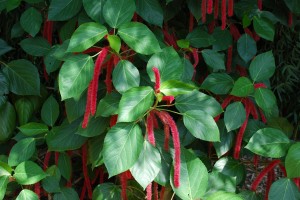Chenille plant (Acalypha hispida), aka firetails and redhot cattail, is a hot tropical plant which has jumped from house plant to garden plant use. Their pendulous vibrant red (other colors are available) tassel-like flowers mimic the furry tails of pets. Its lush dark green foliage is heart-shaped. Stems arch downward under the weight of the enormous catkin flowers which may be 4-10 inches in length. In a public garden it is common to watch children walk up and touch them.
Under ideal moisture and tropical warmth, chenille may grow to 8-10 feet in height with a 4 to 6 feet spread. Dwarf and trailing forms of chenille (A. pendula or A. repens or A. reptans) are available. Put these in hanging baskets or let them spill over the edge of a large container. Chenille grows to less than half their garden size in containers.
Add chenille to the middle or back of a sunny perennial border to fill in an empty spot over the summer. It starts blooming in the heat of the summer and continues through the warm days of autumn. Mix chenille with other plants with red hues, such as Red Abyssinian banana, coleus, ‘Strawberry Fields’ gomphrena, among other options.
Chenille grows vigorously. It prefers a moist, well-drained soil with adequate watering through the normally dry summer. Pruning plant(s) back by half in early July develops a compact, more floriferous habit. Occasionally remove spent flowers to keep chenille tidy.
Chenille plant may be grown as a house plant. Cuttings root easily, gathered from plants in the garden. Be vigilant not to invite garden pests indoors in the fall, an easy thing to do. Tropical chenille thrives in a warm humid room with a temperature minimum of 60 °F and full day sunlight. These environmental conditions are best found in a sun room or greenhouse.
Warning: chenille plant belongs to the Euphorbia family; its sap is mildly toxic to people and pets, and may cause eye irritation and dermatitis. Young children are particularly attracted to the bright fuzzy pendulous flowers.


 Posted in
Posted in 
